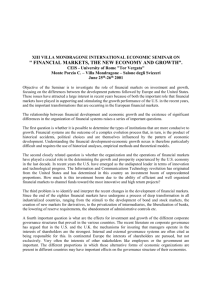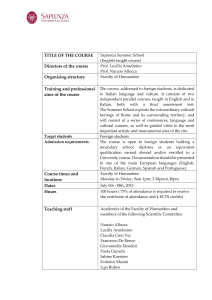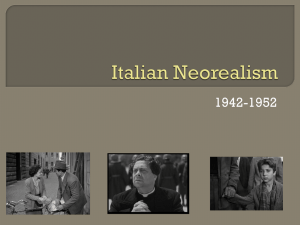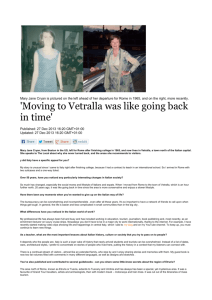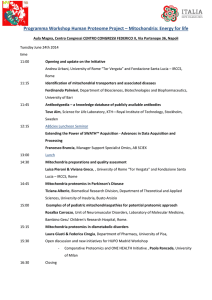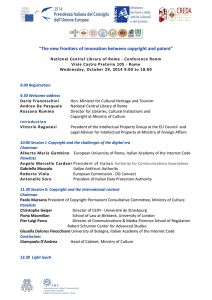Tor Vergata - Fall 2013 - BI Norwegian Business School
advertisement
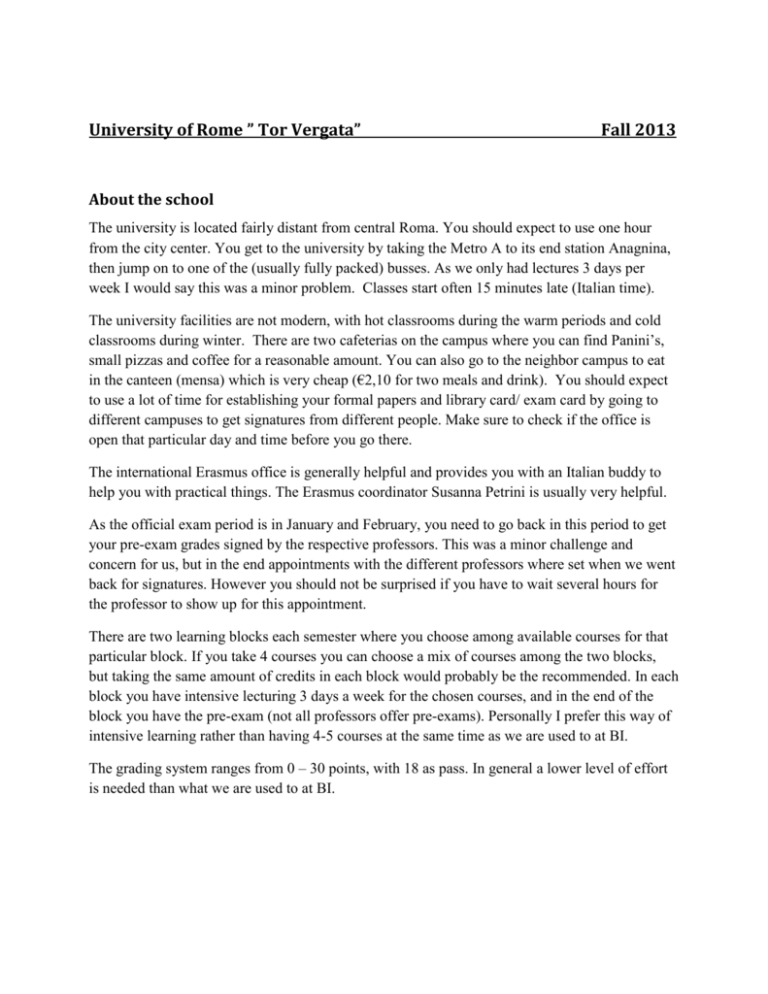
University of Rome ” Tor Vergata” Fall 2013 About the school The university is located fairly distant from central Roma. You should expect to use one hour from the city center. You get to the university by taking the Metro A to its end station Anagnina, then jump on to one of the (usually fully packed) busses. As we only had lectures 3 days per week I would say this was a minor problem. Classes start often 15 minutes late (Italian time). The university facilities are not modern, with hot classrooms during the warm periods and cold classrooms during winter. There are two cafeterias on the campus where you can find Panini’s, small pizzas and coffee for a reasonable amount. You can also go to the neighbor campus to eat in the canteen (mensa) which is very cheap (€2,10 for two meals and drink). You should expect to use a lot of time for establishing your formal papers and library card/ exam card by going to different campuses to get signatures from different people. Make sure to check if the office is open that particular day and time before you go there. The international Erasmus office is generally helpful and provides you with an Italian buddy to help you with practical things. The Erasmus coordinator Susanna Petrini is usually very helpful. As the official exam period is in January and February, you need to go back in this period to get your pre-exam grades signed by the respective professors. This was a minor challenge and concern for us, but in the end appointments with the different professors where set when we went back for signatures. However you should not be surprised if you have to wait several hours for the professor to show up for this appointment. There are two learning blocks each semester where you choose among available courses for that particular block. If you take 4 courses you can choose a mix of courses among the two blocks, but taking the same amount of credits in each block would probably be the recommended. In each block you have intensive lecturing 3 days a week for the chosen courses, and in the end of the block you have the pre-exam (not all professors offer pre-exams). Personally I prefer this way of intensive learning rather than having 4-5 courses at the same time as we are used to at BI. The grading system ranges from 0 – 30 points, with 18 as pass. In general a lower level of effort is needed than what we are used to at BI. Courses: General Management (12 ECTS): This course runs over the two learning blocks for the fall semester and is a first year master course for the MSc degree in Business and Economics at the university. The first part of the course concerns the evolution of the firm; Product life cycle, innovation and change. Lecture notes are uploaded and articles provided. The second block concerns the different internal departments of a firm; sales, marketing, logistics, operations, HR etc. Two exams are offered, one after each block. The final grade is an average of your two separate exam scores. As a student you can also participate in debates and projects which can give you additional points that can be added to your final exam score. International Marketing (6 ECTS) This course concerns the basics of international marketing, with theoretical concepts and models. The lectures are based on a text book and hand-outs from the professor. In addition to attendance, the students must hand in a term paper and present it in class. The grade for the course was the weighted average of the score of the term paper and the result from the pre-exam. Organizational Dynamics & Behaviour (6 ECTS) The course is divided into 4 different sections: 1) The Organization Behavior Context and Learning Community, 2) Managing Teams, 3) Understanding and Managing Individuals, and 4) Managing Key Organizational Processes. The course is based on a text book and different cases. During the lectures the teacher urges to interaction and discussion of the cases. The students are divided into groups and each group must present one of the cases during the semester. The pre-exam is arranged after the learning block, in our case in October. However, like with the other courses, we had to go back to Tor Vergata in January/February to sign the formal exam papers. Practical information Before leaving Norway We received an e-mail with information from the international office at Tor Vergata in mid-April. It was documents with some information on enrolment, courses and general contact-info if we had questions regarding our upcoming exchange period. Travel Both Norwegian and SAS are flying directly to Rome (Fiumicino) from Oslo Gardermoen, while Ryanair is flying from Oslo Rygge to Rome (Ciampino). When arriving in Rome, the natural thing to do is to find your way to Stazione Termini. Termini is the central station in Rome, and is connected with trains, busses, metro and taxis. From Fiumicino there are both trains and busses going to Termini. We recommend the “Leonardo da Vinci” express train which goes directly to Termini. We have experienced that there are quite a lot of things that doesn’t work as it should in Italy, but the trains are one service that seems to work better in Italy than what we are used to in Norway. Housing Housing was perhaps the main issue and concern upon arrival in Rome. Neither of us had arranged housing before leaving for Rome. The university is helpful with housing and offers rooms in Campus X and “apartment tours” for its incoming exchange students. “Campus X” is a new complex with rooms for students. It looks quite nice but we would definitely not recommend this as it is far from the city center. The apartment tours are arranged by the organization SPQE and mr. Lorenzo Falli which is also organizing several trips and parties. We did not use their services when arranging housing, but we know that several of our Erasmus-friends did so. However, they were prioritizing students that were going to stay in Rome longer than us, so we got informed that this could not be a possibility for students staying less than 6 months. I (Thomas) booked a room in a B&B for four days upon my arrival, and found an available room in an apartment for the rest of my stay through the website www.airbnb.com during these first days. The apartment was quite new and was in the area of Garbatella. The area is quite far from school but close to the city center, and well connected by both metro (metro B) and busses. In general I would strongly recommend to live close to the city center and close to a metro stop rather than living nearby Tor Vergata. I (Kristoffer) used the Italian housing website easystanza.it with help from google translate. The situation was a bit frustrating, as the landlords did want to rent out to people staying for a longer period. After four days of searching I was lucky and found a room in the San Giovanni Area which is close to the city and on the Metro A that takes you to Tor Vergata. My landlord was a really nice man who owns several apartments in Rome and he prefers to rent out to foreigners. His email address is paolobenassi@me.com and he will be happy to help you find a place to stay. I shared a flat with 4 Italians, of which 2 did not speak English so that is a recommendation if you want to kick start your Italian. Costs Housing is not very cheap in Rome, and we paid 550 and 600 (+ fees) euros respectively per month. We didn’t spend much on books as most of the teaching materials are hand-outs, slides and articles that are available online. Another expense is the monthly metro ticket. This year it was 35 euros per month. It is valid from the 1st until the 31st/30th of every month, so make sure you buy the ticket early in the month. It is valid for metro, bus and tram as well as for some of the local trains. Culture and language In general, the English skills of the Italians are not very good. However, at school we didn’t experience many problems related to the language. The courses are thought in English, and the Italian students in our classes spoke English quite ok. We would recommend you to learn some basic Italian before leaving as this will be helpful. None of us made an effort to learn the language very well, but you will automatically pick up some basics when you live in Rome. Rome is a fantastic city, and there is always something new to see and experience. If people ask me what I think is the best thing to do in Rome, my answer is to just go for walks around the city. It is like a giant outdoor museum, and there are always new aspects to explore. The history of Rome speaks for itself and the atmosphere in “the eternal city” is quite unique. Rome has a great location for exploring the rest of Italy, and the Frecciarossa and Italo speedtrains are great when travelling within the country. We traveled to Milano, Firenze, Venezia, Napoli and Capri, and to the Puglia area. One thing we find amazing about this country is that every small place is genuine and has its own soul. One of the best things about Italy is obviously the food and wine. Ask the romans you meet where you can find the best pizza, pasta or gelato and you will often discover new places that are outside of the typical tourist areas. One of my top food experiences was Osteria del Cavalerie (booking needed). We have both had a fantastic exchange period in Rome and would really recommend it for those of you who want to experience la dolce vita. If your main objective is to be academically challenged, then Tor Vergata is not ideal, as we consider the academic level to be lower than at BI. However, if you want to challenge yourself and experience one of the greatest cities in the world, then you should spend your exchange semester in Rome!
